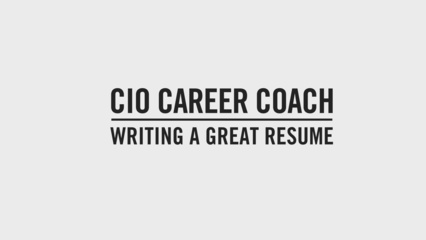advertisement
IT Resume Makeover: Prove your path to CIO on page one
Once you hit the executive level, your resume needs to show what you can offer beyond your career history and…

Once you hit the executive level, your resume needs to show what you can offer beyond your career history and education. Phillip Marlowe, whose name has been changed for this makeover, had an IT resume that looked like most others — long in verbiage and short on professional branding.
J.M. Auron, a global IT careers leader, resume writer and owner of Quantum Tech Resumes, took on the task of bringing more clarity to Marlowe’s resume. His main objective started with digging into Marlowe’s career history to paint a better picture of what Marlowe can offer as a CIO. Auron also aimed to shorten the resume – creating a clear, concise message to hiring managers and recruiters about Marlowe’s value.
Marlowe agreed with Auron’s assessment of his resume, noting that his “resume was too long” and that it was “missing the impact” he felt it should have, especially for a C-suite position.
advertisement
“We discussed his future objectives, his unique value proposition, and then went into detail on his career. As always, I encouraged him to think in terms of CAR — challenges, actions, and results — to dig deeper and unearth his very real accomplishments,” says Auron.
Start strong on the first page
Your resume needs to show exactly who you are as an executive candidate, leaving little room for hiring managers to make their own judgements, or simply pass you over.
“The first page is the most crucial section on any resume — it has to give a clear sense of the candidate’s value proposition, and then hit the reader hard with critical, recent accomplishments,” says Auron.
advertisement
But he says the first page of Marlowe’s resume was “wasted with relatively vague statements that did not define what he had done — or more importantly, what he can do in a future role,” says Auron.
After evaluating Marlowe’s career history and conducting phone interviews, Auron pulled the most impressive accomplishments and included them in the executive summary. Statements like “builds profitable, successful organizations from scratch” and “analyzes current and evolving market trends to develop long-term solutions,” paint a picture of Marlowe as an IT leader, while defining his value.
advertisement
These statements also set the reader up for your career story — they can find the evidence to back up these statements in the rest of the document.
Building clarity with a career story
Marlowe’s original resume included long, bulleted lists that outlined his responsibilities and accomplishments dating as far back as the early ’90s. While this format tells a linear story, it doesn’t tell your career story.
“You do not want to make the hiring authority hunt for your accomplishments. They won’t,” says Auron.
It’s up to you to show the hiring manager how your accomplishments have produced real results. Auron lays out Marlowe’s strong points in the header of every page, reminding the reader he is striving for a CIO role and that he defines himself as “strategic, flexible, results-oriented, entrepreneurial and financially savvy.”
These are all traits that any business would want in a CIO and they also pull the reader in, letting the hiring manager know what they can expect from you as a candidate.
Where Auron lists Marlowe’s experience, he gives clear examples of situations where Marlowe’s skills were put to the test. These include statements like “cut total OpEx costs by 40 percent” and “transformed adversarial relationship between IT and business users.”
Including actionable results not only show Marlowe’s experience, they can also pique the hiring manager’s interest, motivating them to bring you in for an interview.
The ten-year cutoff
Once you’ve been in the workforce long enough to climb the corporate ladder, it gets difficult to keep your resume to one or two pages. Marlowe’s resume had grown to four pages after trying to include his entire portfolio of experience. To shorten the resume, Auron used a ten-year cutoff to eliminate extraneous details.
“No more than a decade needs to be discussed in detail — and earlier career can lead to the very real problem of age discrimination,” says Auron.
There will always be exceptions — for example, if you have been at one job for longer than a decade — but it’s a good rule of thumb when deciding what to cut from your final draft. In this case, it helped Auron bring Marlowe’s resume down to three pages that better exemplified him as a CIO candidate.
Final result
Marlowe was pleased with the result and — as with many candidates — even he was impressed at his own work experience and history.
Auron counts this as another successful “challenges, actions and results”–focused IT resume in the books. He not only shortened Marlowe’s lengthy resume, but created a document that will help Marlowe land his next executive interview.
“I leveraged the information I got in my interview with Phil to build a much clearer, more focused picture of what he has done — and what he can do. The new resume is focused on achievements — Phil has many. He’s done some great things; I crafted a resume that clearly details what he’s done for a future opportunity,” says Auron.